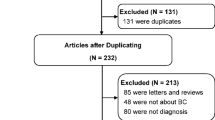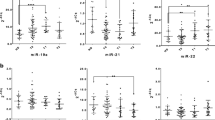Abstract
Accumulating evidence has suggested that concentrations of blood-based circulating micro-ribonucleic acids (microRNAs, miRNAs) in breast tumor patients are significantly higher/lower than that in normal individuals, indicating that circulating miRNAs may serve as novel blood-based biomarkers for breast tumor. However, the results of previous studies on this issue have been inconclusive. Therefore, we perform a meta-analysis to determine whether aberrant miRNA expression can be used as molecular markers in blood for the diagnosis of breast tumor. PubMed and other databases were searched to identify eligible studies. The sensitivity and specificity were used to plot the summary receiver operator characteristic curve and calculate the area under the curve (AUC). Finally, 15 articles with a total of 1,428 breast tumor patients and 952 healthy individuals were involved. The summary estimates revealed that the pooled sensitivity was 76 % with 95 % confidence interval (CI) of 67–83 %; the specificity was 87 % with 95 % CI of 77–93 %; the PLR was 5.9 with 95 % CI of 3.3–10.4; the NLR was 0.28 with 95 % CI of 0.20–0.39; the DOR was 21 with 95 % CI of 10–44; and the AUC was 0.88 with 95 % CI of 0.84–0.90. The most noteworthy is that multiple-miRNA assay displayed a better diagnostic performance than single-miRNA assay. In summary, the results of the present meta-analysis suggested that blood-based miRNAs may serve as novel molecular biomarkers for breast tumor, with a relative high level of accuracy, especially based on multiple-miRNA assay. Further large-scale prospective studies are necessary to validate their potential applicability for breast tumor prognosis, treatment, and surveillance.





Similar content being viewed by others
References
Dinnes J, Deeks J, Kirby J, Roderick P. A methodological review of how heterogeneity has been examined in systematic reviews of diagnostic test accuracy. Health Technol Assess. 2005;9:1–113. iii.
Jemal A, Bray F, Center MM, Ferlay J, Ward E, Forman D. Global tumor statistics. CA Tumor J Clin. 2011;61:69–90. doi:10.3322/caac.20107.
Parkin DM, Bray F, Ferlay J, Pisani P. Global tumor statistics, 2002. CA Tumor J Clin. 2005;55:74–108.
Yang L, Parkin DM, Ferlay J, Li L, Chen Y. Estimates of tumor incidence in China for 2000 and projections for 2005. Tumor Epidemiol Biomarkers Prev. 2005;14:243–50.
Duffy MJ. Role of tumor markers in patients with solid tumors: a critical review. Eur J Intern Med. 2007;18:175–84. doi:10.1016/j.ejim.2006.12.001.
Roulston JE. Limitations of tumour markers in screening. Br J Surg. 1990;77:961–2.
Rembold H. Metabolism and metabolic roles of 6-polyhydroxyalkylpterins. J Inherit Metab Dis. 1978;1:61–2.
Fassan M, Volinia S, Palatini J, Pizzi M, Baffa R, De Bernard M, et al. MicroRNA expression profiling in human Barrett’s carcinogenesis. Int J Tumor. 2011;129:1661–70. doi:10.1002/ijc.25823.
Jones CM, Athanasiou T. Summary receiver operating characteristic curve analysis techniques in the evaluation of diagnostic tests. Ann Thorac Surg. 2005;79:16–20. doi:10.1016/j.athoracsur.2004.09.040.
Heneghan HM, Miller N, Kelly R, Newell J, Kerin MJ. Systemic miRNA-195 differentiates breast tumor from other malignancies and is a potential biomarker for detecting noninvasive and early stage disease. Oncologist. 2010;15:673–82. doi:10.1634/theoncologist.2010-0103.
Mao Q, Guo H, Gao L, Wang H, Ma X. Peroxisome proliferator-activated receptor gamma2 Pro12Ala (rs1801282) polymorphism and breast tumor susceptibility: a meta-analysis. Mol Med Rep. 2013;8:1773–8. doi:10.3892/mmr.2013.1735.
Zamora J, Abraira V, Muriel A, Khan K, Coomarasamy A. Meta-DiSc: a software for meta-analysis of test accuracy data. BMC Med Res Methodol. 2006;6:31. doi:10.1186/1471-2288-6-31.
Zhu J, Wu L, Kohlmeier M, Ye F, Cai W. Association between MTHFR C677T, MTHFR A1298C and MS A2756G polymorphisms and risk of cervical intraepithelial neoplasia II/III and cervical tumor: a meta-analysis. Mol Med Rep. 2013;8:919–27. doi:10.3892/mmr.2013.1589.
Glas AS, Lijmer JG, Prins MH, Bonsel GJ, Bossuyt PM. The diagnostic odds ratio: a single indicator of test performance. J Clin Epidemiol. 2003;56:1129–35.
Zhang J, Wang Y, Liu Y, Zhang X. Lack of association between CYP1A1 T6235C polymorphism and coronary artery disease: evidence from a meta-analysis. Mol Med Rep. 2013;7:543–8. doi:10.3892/mmr.2012.1212.
Hao SW, Jin QH. Association between the +104 T/C polymorphism in the 5’UTR of GDF5 and susceptibility to knee osteoarthritis: a meta-analysis. Mol Med Rep. 2013;7:485–8. doi:10.3892/mmr.2012.1179.
Wang YJ, Pan Y. Angiotensinogen gene M235T polymorphism and risk of coronary artery disease: a meta-analysis. Mol Med Rep. 2012;6:884–8. doi:10.3892/mmr.2012.1011.
Liu G, Sun G, Wang Y, Wang D, Hu W, Zhang J. Association between manganese superoxide dismutase gene polymorphism and breast tumor risk: a meta-analysis of 17,842 subjects. Mol Med Rep. 2012;6:797–804. doi:10.3892/mmr.2012.998.
Ding DL, Liu SJ, Zhu HZ. Association between the CCR2-Val64Ile polymorphism and susceptibility to HIV-1 infection: a meta-analysis. Mol Med Rep. 2011;4:181–6. doi:10.3892/mmr.2010.400.
Zeng XT, Tang XJ, Wang XJ, Li MZ, Guo Y, Huang W, et al. AlloDerm implants for prevention of Frey syndrome after parotidectomy: a systematic review and meta-analysis. Mol Med Rep. 2012;5:974–80. doi:10.3892/mmr.2012.762.
Garzon R, Fabbri M, Cimmino A, Calin GA, Croce CM. MicroRNA expression and function in tumor. Trends Mol Med. 2006;12:580–7. doi:10.1016/j.molmed.2006.10.006.
Jay C, Nemunaitis J, Chen P, Fulgham P, Tong AW. miRNA profiling for diagnosis and prognosis of human tumor. DNA Cell Biol. 2007;26:293–300. doi:10.1089/dna.2006.0554.
Motoyama K, Inoue H, Takatsuno Y, Tanaka F, Mimori K, Uetake H, et al. Over- and under-expressed microRNAs in human colorectal tumor. Int J Oncol. 2009;34:1069–75.
Xie Y, Todd NW, Liu Z, Zhan M, Fang H, Peng H, et al. Altered miRNA expression in sputum for diagnosis of non-small cell lung tumor. Lung Tumor. 2010;67:170–6. doi:10.1016/j.lungcan.2009.04.004.
Tsujiura M, Ichikawa D, Komatsu S, Shiozaki A, Takeshita H, Kosuga T, et al. Circulating microRNAs in plasma of patients with gastric tumors. Br J Tumor. 2010;102:1174–9. doi:10.1038/sj.bjc.6605608.
Schepeler T, Reinert JT, Ostenfeld MS, Christensen LL, Silahtaroglu AN, Dyrskjot L, et al. Diagnostic and prognostic microRNAs in stage II colon tumor. Tumor Res. 2008;68:6416–24. doi:10.1158/0008-5472.CAN-07-6110.
Heneghan HM, Miller N, Lowery AJ, Sweeney KJ, Newell J, Kerin MJ. Circulating microRNAs as novel minimally invasive biomarkers for breast tumor. Ann Surg. 2010;251:499–505. doi:10.1097/SLA.0b013e3181cc939f.
Mar-Aguilar F, Mendoza-Ramirez JA, Malagon-Santiago I, Espino-Silva PK, Santuario-Facio SK, Ruiz-Flores P, et al. Serum circulating microRNA profiling for identification of potential breast tumor biomarkers. Dis Markers. 2013;34:163–9. doi:10.3233/dma-120957.
Asaga S, Kuo C, Nguyen T, Terpenning M, Giuliano AE, Hoon DS. Direct serum assay for microRNA-21 concentrations in early and advanced breast tumor. Clin Chem. 2011;57:84–91. doi:10.1373/clinchem.2010.151845.
Moher D, Liberati A, Tetzlaff J, Altman DG. Preferred reporting items for systematic reviews and meta-analyses: the PRISMA statement. Ann Intern Med. 2009;151:264–9. W264.
Whiting PF, Rutjes AW, Westwood ME, Mallett S, Deeks JJ, Reitsma JB, et al. QUADAS-2: a revised tool for the quality assessment of diagnostic accuracy studies. Ann Intern Med. 2011;155:529–36. doi:10.7326/0003-4819-155-8-201110180-00009.
Higgins JP, Thompson SG, Deeks JJ, Altman DG. Measuring inconsistency in meta-analyses. BMJ. 2003;327:557–60. doi:10.1136/bmj.327.7414.557.
Jackson D, White IR, Thompson SG. Extending DerSimonian and Laird’s methodology to perform multivariate random effects meta-analyses. Stat Med. 2010;29:1282–97. doi:10.1002/sim.3602.
Deeks JJ, Macaskill P, Irwig L. The performance of tests of publication bias and other sample size effects in systematic reviews of diagnostic test accuracy was assessed. J Clin Epidemiol. 2005;58:882–93. doi:10.1016/j.jclinepi.2005.01.016.
Guo LJ, Zhang QY. Decreased serum miR-181a is a potential new tool for breast tumor screening. Int J Mol Med. 2012;30:680–6. doi:10.3892/ijmm.2012.1021.
Hu Z, Dong J, Wang LE, Ma H, Liu J, Zhao Y, et al. Serum microRNA profiling and breast tumor risk: the use of miR-484/191 as endogenous controls. Carcinogenesis. 2012;33:828–34. doi:10.1093/carcin/bgs030.
Madhavan D, Zucknick M, Wallwiener M, Cuk K, Modugno C, Scharpff M, et al. Circulating miRNAs as surrogate markers for circulating tumor cells and prognostic markers in metastatic breast tumor. Clin Tumor Res. 2012;18:5972–82. doi:10.1158/1078-0432.ccr-12-1407.
Schrauder MG, Strick R, Schulz-Wendtland R, Strissel PL, Kahmann L, Loehberg CR, et al. Circulating micro-RNAs as potential blood-based markers for early stage breast tumor detection. PLoS ONE. 2012;7:e29770. doi:10.1371/journal.pone.0029770.
Sun Y, Wang M, Lin G, Sun S, Li X, Qi J, et al. Serum microRNA-155 as a potential biomarker to track disease in breast tumor. PLoS ONE. 2012;7:e47003. doi:10.1371/journal.pone.0047003.
Wang B, Zhang Q. The expression and clinical significance of circulating microRNA-21 in serum of five solid tumors. J Tumor Res Clin Oncol. 2012;138:1659–66. doi:10.1007/s00432-012-1244-9.
Wu Q, Wang C, Lu Z, Guo L, Ge Q. Analysis of serum genome-wide microRNAs for breast tumor detection. Clin Chim Acta. 2012;413:1058–65. doi:10.1016/j.cca.2012.02.016.
Cuk K, Zucknick M, Heil J, Madhavan D, Schott S, Turchinovich A, et al. Circulating microRNAs in plasma as early detection markers for breast tumor. Int J Tumor. 2013;132:1602–12. doi:10.1002/ijc.27799.
Eichelser C, Flesch-Janys D, Chang-Claude J, Pantel K, Schwarzenbach H. Deregulated serum concentrations of circulating cell-free microRNAs miR-17, miR-34a, miR-155, and miR-373 in human breast tumor development and progression. Clin Chem. 2013;59:1489–96. doi:10.1373/clinchem.2013.205161.
Gao J, Zhang Q, Xu J, Guo L, Li X. Clinical significance of serum miR-21 in breast tumor compared with CA153 and CEA. Chin J Tumor Res. 2013;25:743–8. doi:10.3978/j.issn.1000-9604.2013.12.04.
Zeng RC, Zhang W, Yan XQ, Ye ZQ, Chen ED, Huang DP, et al. Down-regulation of miRNA-30a in human plasma is a novel marker for breast tumor. Med Oncol. 2013;30:477. doi:10.1007/s12032-013-0477-z.
McDermott AM, Miller N, Wall D, Martyn LM, Ball G, Sweeney KJ, et al. Identification and validation of oncologic miRNA biomarkers for Luminal A-like breast tumor. PLoS ONE. 2014;9:e87032. doi:10.1371/journal.pone.0087032.
Conflicts of interest
None
Author information
Authors and Affiliations
Corresponding author
Electronic supplementary material
Below is the link to the electronic supplementary material.
Supplement S1
The PRISMA Checklist. (DOC 57 kb)
Supplement S2
The QUADAS-2 Checklist. (PDF 265 kb)
Rights and permissions
About this article
Cite this article
Xin, H., Li, X., Yang, B. et al. Blood-based multiple-microRNA assay displays a better diagnostic performance than single-microRNA assay in the diagnosis of breast tumor. Tumor Biol. 35, 12635–12643 (2014). https://doi.org/10.1007/s13277-014-2587-4
Received:
Accepted:
Published:
Issue Date:
DOI: https://doi.org/10.1007/s13277-014-2587-4




